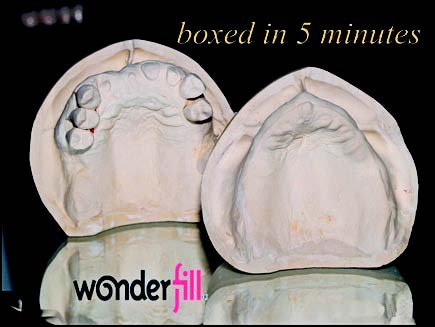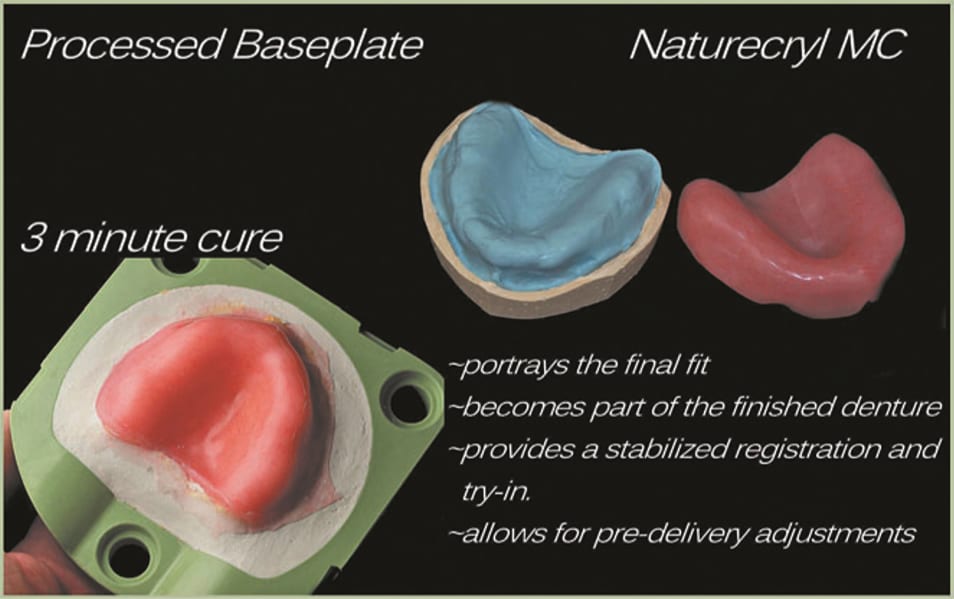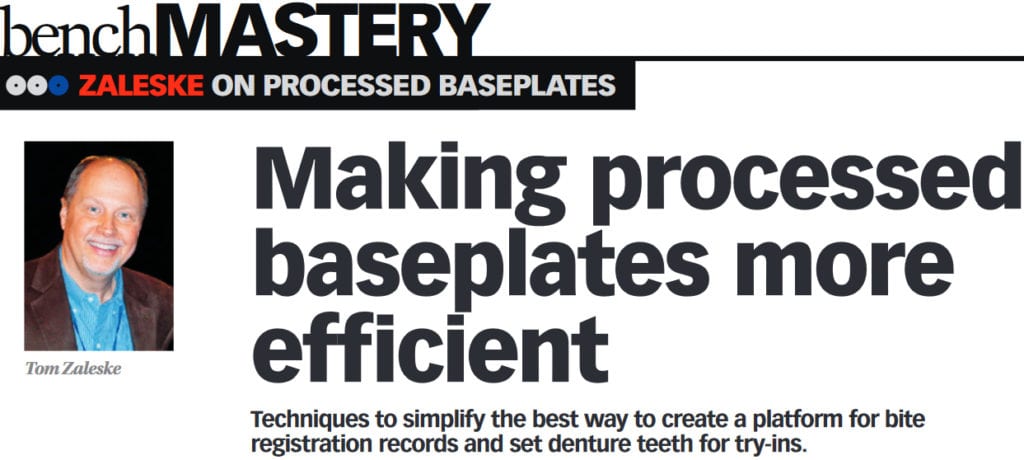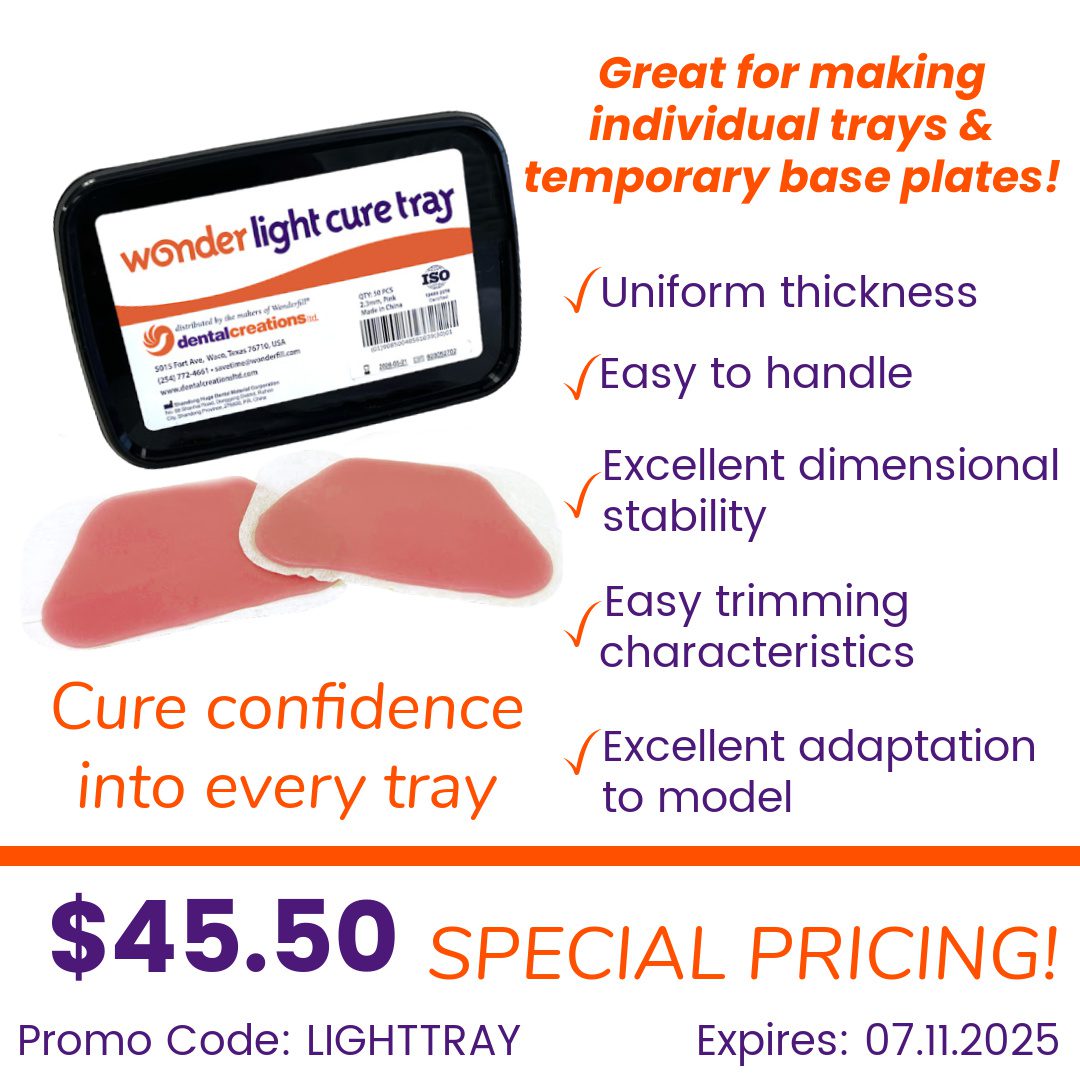Several authors over the years have written about the benefits of using processed baseplates as the surest way to present a stable, retentive platform on which to take bite registration records and set denture teeth on for try-in evaluation. Other benefits include providing the exact ft to be expected prior to the finish of the case, and providing a treatment tool to help clinicians illustrate the deficiency or success of treatment expectation to their patient.
The biggest disadvantage in offering these types of bases always has been in the time it takes in the laboratory to fabricate them and the fee associated with that time.
Broken down into the key elements of fabrication, this article will provide a huge time-saving cure method and a product that will provide a more accurate end product.

Fig. 1 By boxing the master impression with Wonderfll and the Wonderformer, 15 minutes of additional time can be saved.

Fig. 2 Vacuum formable sheets of baseplate (pink) or tray (blue) offer an inexpensive and accurate way to control uniformity of thickness in the processed baseplate. I prefer to use the .100 thick pink, which provides a uniform 1.5 mm post formed thickness

Fig. 3 Cutting material away from the model can be quickly achieved by using a standard stiff Robinson brush, using controlled speed and pressure. 8-10k rpm provides an even speed that cuts the material more than disintegrating the brush.

Fig. 4 By implementing microwave curing into processing baseplates, you not only save two hours of waiting time, but it also keeps you from tying up conventional curing baths with an ancillary procedure. For more on microwave curing using GC Naturecryl MC, they offer a one-hour webinar by this author, for CE Credit at bit.ly/J2rIYA

Fig. 5 Fabricating a mounting model with lab putty and a stone base ensures easy, accurate placement and removal from articulated mounting. Make sure to encompass the border roll and ridge form; place retention holes in putty while soft to provide putty to stone retention when you pour the base.

Fig. 6 All-season wax from Yates and Motloid ensures a distortion free record. Baseplates have post dam placed and are polished and finished at the border final, to ensure the truest evaluation of fit.

Fig. 7 Once approved, the try-in/processed base is filled with stone to invest. Never process on the lab putty mounting model.

Fig. 8 When investing, cover acrylic up to the wax interface. This will allow flasks to separate easily and provide a non-flashing pack.

Fig. 9 Some of the benefits of Naturecryl MC.
01 Once the master impression has been boxed (Fig. 1), poured and stone has set, a replication of the baseplate must be formed over the model before in-vesting. Using baseplate wax is the general recommendation for this task. The draw-back in using this material is the uniformity in thickness, contour, speed and accuracy of adaption. When heated and hand-formed, wax tends to get thinner in areas that have pressed over surface elevations such as tuberosity’s and palatine raphe. I recommend using vacuum formable polystyrene sheets (Fig. 2) sold as baseplate and tray material. The ability to heat and form over the model provides a tight, uniformly thick adaption that covers the tissue-bearing surface and follows the contour of the palatal vault. Trimming is easily accomplished using a stiff Robinson brush, or hot knife (Fig. 3). Using the .100 gauge material provides a 1.5 mm thick base with no inconsistency of gauge.
02 Once invested, we have to choose a way to cure that is time-effective and won’t tie up our conventional curing equipment for any length of time. I have found that solution by using GC Naturecryl MC Microwave acrylic and FRP Flask (Fig. 4). I have been using this acrylic for other types of fabrications but have now found its three-minute cure feature to be an ideal recommendation for this application as well.
03 Being able to use conventional flasking technique, mold washout and pack pressing technique with this product eliminates any real learning curve. The ability to start finishing the baseplate in 48 minutes from onset of cure removed my usual two-and-a-half-to-three-hour wait for conventional resin and made this a more time effective service to offer. Naturecryl MC also matches Naturecryl Super Hi Impact resin in shade, so that when I do my secondary cure with teeth on the base, I am confident the shade blending will be identical.
04 Once the baseplate is cured, a “mounting model” is fabricated using PVS laboratory putty and a stone base (Fig. 5). This ensures the baseplate can be removed and placed at will with no concern of undercut. Fill just enough of the tissue bearing area with putty to encompass the border roll and ridge. Place retention undercuts into the putty while soft to lock the stone to be poured as a base to it.
05 Fabricate a rim, using a firm, all-season wax such as Yates and Motloid (Fig. 6) to the base with sticky wax. All-season wax ensures a stable bite registration and consequent wax arrangement as it is resistant to warping or moving over a wide range of temperatures. I also have found it to have a natural pink pigment, and it has a nice carving and flaming property.
06 Once try-in is approved, always process off the putty model by filling the baseplate with stone to make a “processing” base (Figs. 7 and 8). I recommend a secondary curing temperature not to exceed 165° F, as boiling may relax and distort the pre-processed acrylic.By implementing GC Naturecryl MC into the fabrication of what was once considered time consuming, it has allowed me to offer a better service to my clients, without compromising production schedules in the lab.
Article by: Tom Zaleske
About the Author: Tom Zaleske is the owner of Matrix Dental Laboratory in Crown Point, Ind., and has more than 25 years of experience in removable prosth-odontics. He regularly lectures on providing high quality service to dentists and, most importantly, to their patients. He can be reached at matrixdental@comcast.net.


